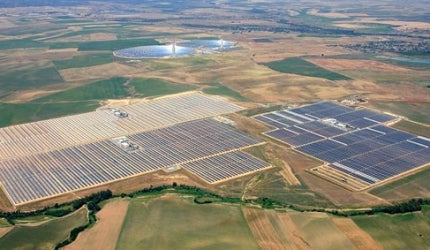
Solnova Solar Power Station is a concentrating solar plant located within Europe’s largest solar complex, Solúcar Complex. Owned by Abengoa Solar the complex is located in Solúcar la Mayor near Seville, Spain.
The Solnova power station will be the world’s largest concentrating solar power plant with an installed capacity of 250MW upon completion. The plant is being built in five stages of 50MW each. Its groundbreaking ceremony was held in 2007. The units 1, 3 and 4 became operational in 2010, while units 2 and 5 are in development stage.
The three operational units are also provided with gas as an alternative source for generating power.
Abengoa Solar is the owner, constructor and operator of Solnova Solar Power Station.
The larger Solúcar Complex aims to serve 153,000 households and cut 185,000t of carbon dioxide emissions annually, with a total installed capacity of 300MW. It will be spread over 2,471 acres (1,000ha) of land and will cost an estimated €1.2bn ($1.5bn). The photovoltaic (PV) plants that make up the complex include PS10, PS20, Solnova, Sevilla PV and Casaquemada PV.
PS10 and PS20, using power tower technology, have an installed capacity of 11MW and 20MW respectively. Sevilla PV and Casaquemada PV, which use PV technology, are relatively smaller plants with installed capacity of 1.2MW and 1MW each.
Details of the Solnova power plant units
Each Solnova power plant unit is built in 284 acres (115ha) of the Solúcar Complex. Each unit consists of approximately 300,000m² (3.23 million ft²) of solar field. Each unit serves approximately 25,700 homes, cutting 31,400t of carbon dioxide emissions annually.
Related project
Solar Tower, Seville, Spain
A futuristic-looking 11MW solar tower has been completed near Seville, Spain as part of a 300MW solar power project.
Unit 1 was the first to be opened for commercial operations, in early May 2010. It was followed by the opening of Unit 3 in the same month and Unit 4 in August 2010.
Each unit employs 360 parabolic trough collectors to reflect the radiation. Other infrastructure includes an oil boiler, thermal oil pipes, a turbine, steam generator and cooling towers.
Also included are two electrical buildings, sewage and effluent treatment plants and an assembly shop.
ASTRØ parabolic trough technology at Solnova Solar Power Station
The Solnova solar power plant utilises ASTRØ parabolic trough technology developed by Abengoa Solar.
The technology involves long rows of curved heliostat mirrors which can be rotated towards the direction of the sun. The mirrors reflect the sunlight which is concentrated onto a pipe containing a fluid (synthetic oil). The fluid heats up to 400°C temperature by absorbing the solar radiation. The hot fluid is transferred via pipes to heat water vapour in a turbine-generator where electricity is produced.
The pipes are insulated to minimise the loss of energy during the transfer of the thermal oil and steam. This is achieved by covering the pipes in glass wool before coating them with aluminium.
Project finance and key players
The estimated construction cost for units 1 and 3 came to around €500m. It was 50% financed by the European Investment Bank.
Solnava 4 cost approximately €210m. It was financed jointly by Banesto, Caja Madrid, Calyon, Dexia Sabadell, ING, Kfw, Ladesbank, Natixis, Santander, Société Générale and Ubibanca. The photovoltaic plants for unit 4 were financed by La Caixa, Sumitomo and West LB.
The construction contract of Solnova units 1 and 3 was awarded to Abener, which appointed Teyma as the subcontractor for the civil works. Solnova 4 was constructed jointly by Abener and Teyma. All the contracts were awarded on a turnkey basis.
The heliostat mirrors were supplied by Rioglass. The valves were supplied by MTS. Bilfinger Berger was responsible for the insulation of pipes and plant components.







